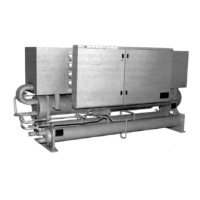66 Product Manual WHR-2
Figure 14, Typical chilled water piping
Condenser Water (EW Units)
Be certain the condenser water enters the bottom connection of the condenser. The condenser
water will exit the condenser from the top connection. Head pressure control must be provided if
the entering condenser water can fall below 60°F. Fan cycling and modulating discharge dampers
on the cooling towers or a three-way bypass valve around the tower is often used. Consult the
tower manufacturer for information on specific applications.
If city or well water is used for condensing, a two-way pressure actuated water regulating valve
should be installed in the outlet piping of each condenser. The condenser purge valve provides a
convenient pressure tap for the regulating valve. The valve can modulate in response to head
pressure. When the compressor shuts down, this valve closes, preventing water from being
siphoned out of the condenser.
Low Temperature Applications
Compressor unloading is acceptable for applications with 35°F or higher leaving fluid temperatures
(LFT). For applications where the LFT is less than 35°F, only full load compressor operation is
allowable. Due to reduced refrigerant flow, motor cooling can become a problem. If compressor
part load operation is required below 35°F LFT, contact the factory for additional requirements. It is
acceptable to use UNT or MicroTech controls for applications with 35°F LFT or lower provided that
only one LFT setpoint is needed.
Ice Storage Applications
Ice storage applications must use Microtech controls. The Microtech has logic to change
setpoints from the low ice making mode to higher normal comfort cooling setpoints. It is important
that the Microtech controller receive a signal to convert from ice mode to normal operating mode.
Microtech includes the logic to keep compressors fully loaded when operating in the ice mode.
The double insulation thickness option is recommend to prevent sweating.
Two Pipe Systems
When the same two pipes are used for both heating and cooling water, several limitations should be
observed. The maximum allowable temperature that the evaporator should experience in a non-
operating mode is 100 degrees Fahrenheit. For unit operation and system changeover from heating
to cooling, the maximum allowable temperature entering the evaporator is 90 degrees Fahrenheit.
System controls provided by others should prevent chiller operation until the loop temperature
drops to 90 degrees. When the loop water temperature ranges between 75 and 90 degrees entering
the evaporator, the high return water staging thermostat should be used to prevent compressor
overloading.

